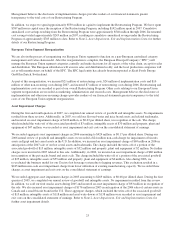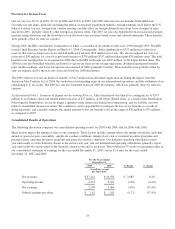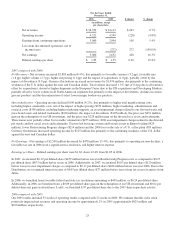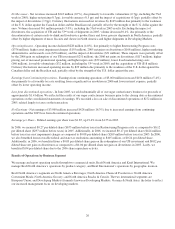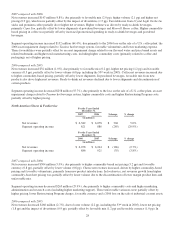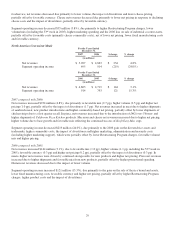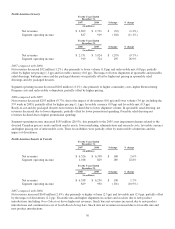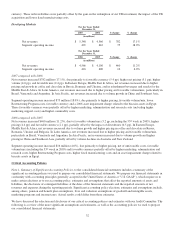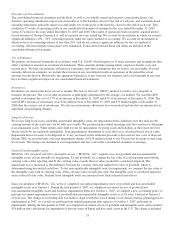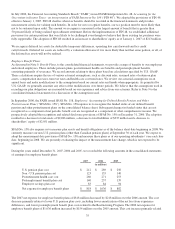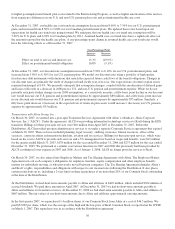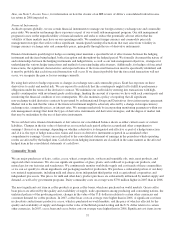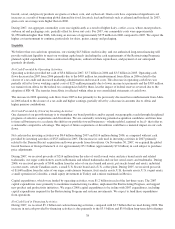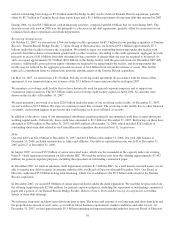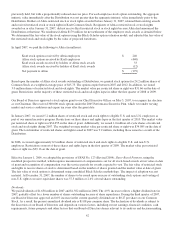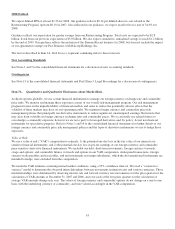Kraft 2007 Annual Report Download - page 48
Download and view the complete annual report
Please find page 48 of the 2007 Kraft annual report below. You can navigate through the pages in the report by either clicking on the pages listed below, or by using the keyword search tool below to find specific information within the annual report.Principles of Consolidation:
The consolidated financial statements include Kraft, as well as our wholly-owned and majority-owned subsidiaries. Our
domestic operating subsidiaries report year-end results as of the Saturday closest to the end of each year, and our international
operating subsidiaries generally report year-end results two weeks prior to the Saturday closest to the end of each year. This
resulted in 53 weeks of operating results in our consolidated statement of earnings for the year ended December 31, 2005,
versus 52 weeks for the years ended December 31, 2007 and 2006. The results of operations from our newly acquired global
biscuit business of Groupe Danone S.A. will be reported on a one month lag. We account for investments in which we exercise
significant influence (20% - 50% ownership interest) under the equity method of accounting. We account for investments in
which we have an ownership interest of less than 20%, and do not exercise significant influence by the cost method of
accounting. All intercompany transactions were eliminated. Transactions between Kraft and Altria are included in the
consolidated financial statements.
Use of Estimates:
We prepare our financial statements in accordance with U.S. GAAP, which requires us to make estimates and assumptions that
affect a number of amounts in our financial statements. These amounts include, among others, employee benefit costs and
income taxes. We base our estimates on historical experience and other assumptions that we believe are reasonable. If actual
amounts differ from estimates, we include the revisions in our consolidated results of operations in the period the actual
amounts become known. Historically, the aggregate differences, if any, between our estimates and actual amounts in any year
have not had a significant impact on our consolidated financial statements.
Inventories:
Inventories are stated at the lower of cost or market. The last-in, first-out (“LIFO”) method is used to cost a majority of
domestic inventories. The cost of other inventories is principally determined by the average cost method. We used the LIFO
method to determine the cost of 37% of inventories at December 31, 2007 and 41% of inventories at December 31, 2006. The
stated LIFO amounts of inventories were $142 million lower at December 31, 2007 and $70 million higher at December 31,
2006 than the current cost of inventories. We also record inventory allowances for overstocked and obsolete inventories due to
ingredient and packaging changes.
Long-Lived Assets:
We review long-lived assets, including amortizable intangible assets, for impairment when conditions exist that indicate the
carrying amount of the assets may not be fully recoverable. We perform undiscounted operating cash flow analyses to determine
if an impairment exists. When testing assets held for use for impairment, we group assets and liabilities at the lowest level for
which cash flows are separately identifiable. If an impairment is determined to exist, the loss is calculated based on fair value.
Impairment losses on assets to be disposed of, if any, are based on the estimated proceeds to be received, less costs of disposal.
During 2006, we recorded non-cash asset impairment charges of $245 million related to our Tassimo hot beverage system long-
lived assets. The charges are included in asset impairment and exit costs in the consolidated statement of earnings.
Goodwill and Intangible assets:
SFAS No. 142, Goodwill and Other Intangible Assets, (“SFAS No. 142”) requires us to test goodwill and non-amortizable
intangible assets at least annually for impairment. To test goodwill, we compare the fair value of each reporting unit with the
carrying value of the reporting unit. If the carrying value exceeds the fair value, goodwill is considered impaired. The
impairment loss is measured as the difference between the carrying value and implied fair value of goodwill, which is
determined using discounted cash flows. To test non-amortizable intangible assets for impairment, we compare the fair value of
the intangible asset with its carrying value. If the carrying value exceeds fair value, the intangible asset is considered impaired
and is reduced to fair value. Definite lived intangible assets are amortized over their estimated useful lives.
Since our adoption of SFAS No. 142, we have completed our annual impairment review of goodwill and non-amortizable
intangible assets as of January 1. During the first quarter of 2007, we completed our annual review of goodwill and
non-amortizable intangible assets and found no impairments. Effective October 1, 2007, we adopted a new accounting policy to
perform our annual impairment review of goodwill and non-amortizable intangible assets as of October 1 instead of January 1
of each year. The change in our testing date was made to align it with the revised timing of our annual strategic planning process
implemented in 2007. As a result, we performed our annual impairment tests again as of October 1, 2007 and found no
impairments. During the first quarter of 2006, we completed our annual review of goodwill and intangible assets and recorded a
$24 million non-cash charge for impairment of biscuits assets in Egypt and hot cereal assets in the U.S. The charge is included
33


